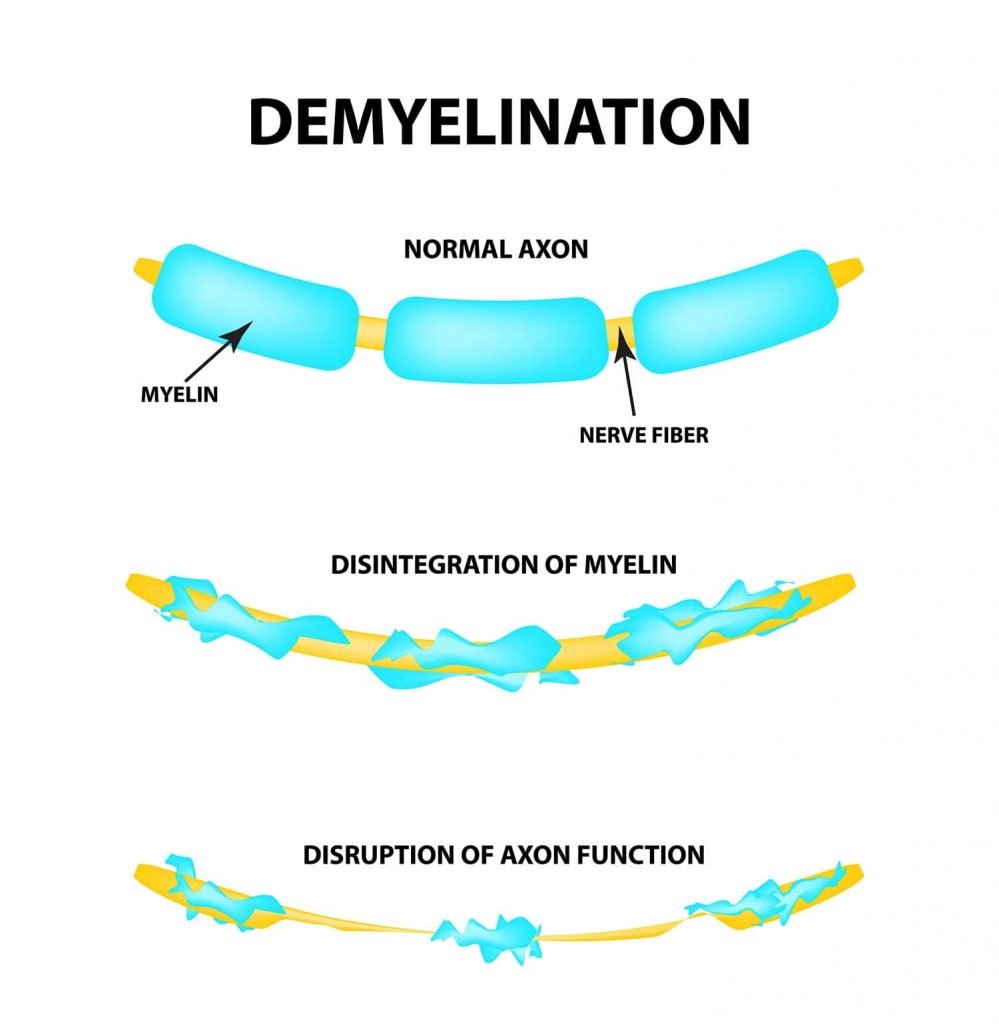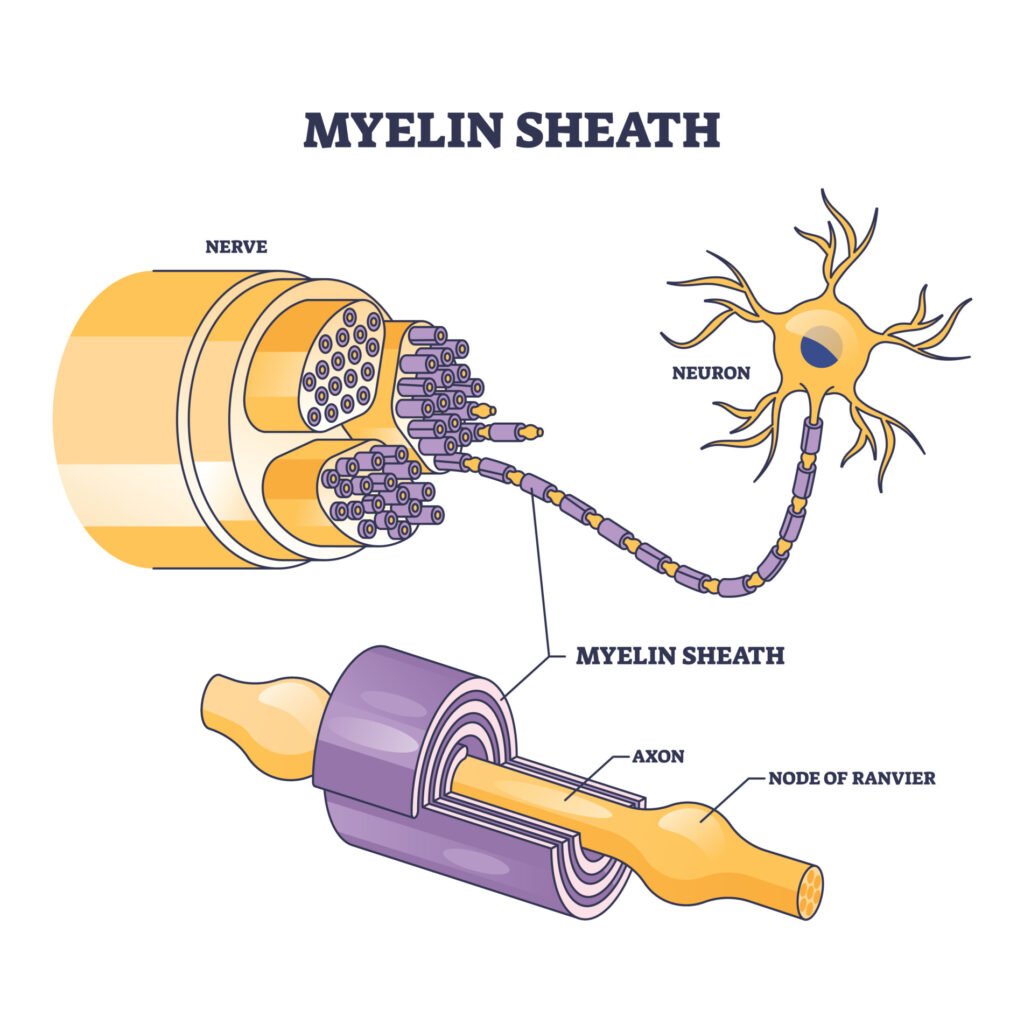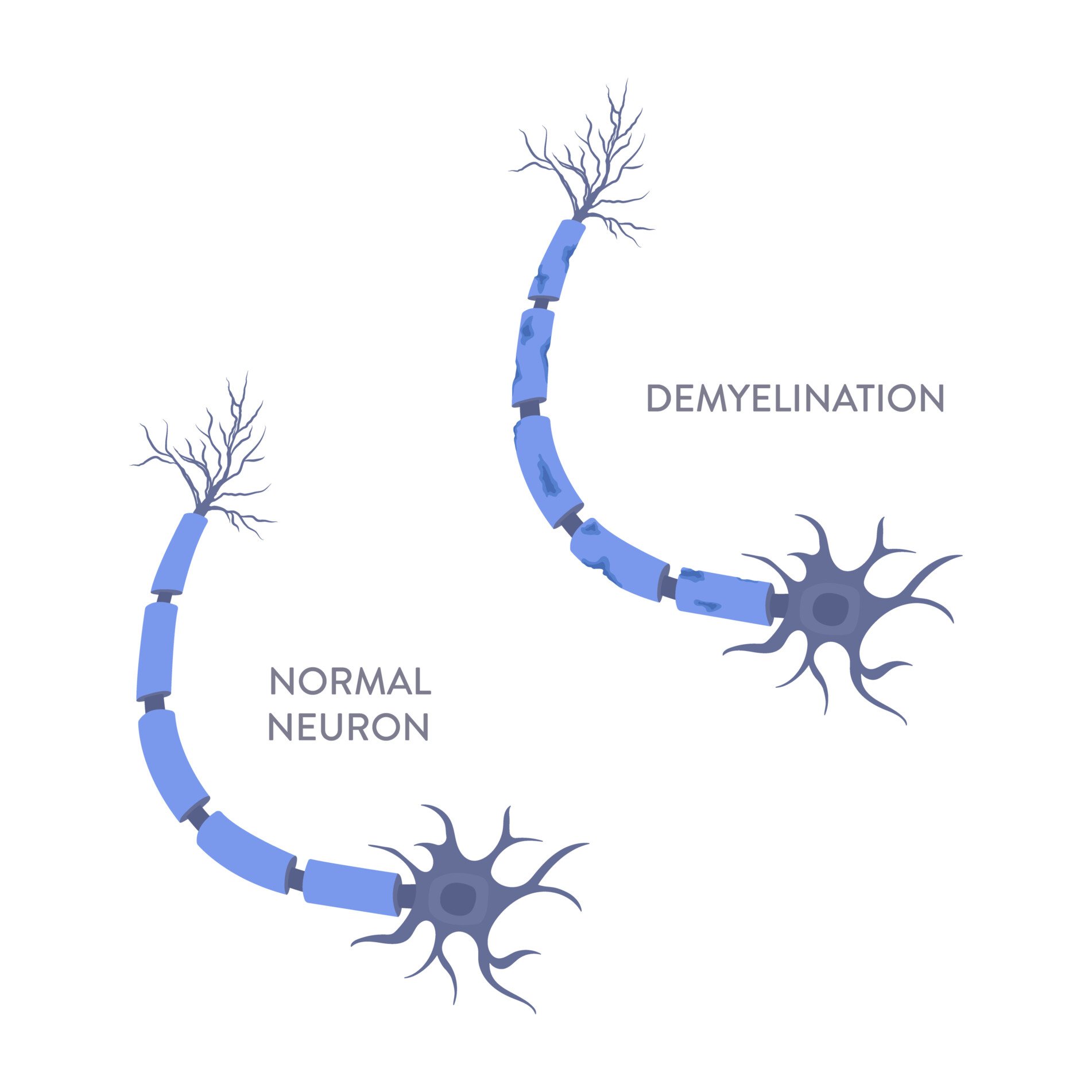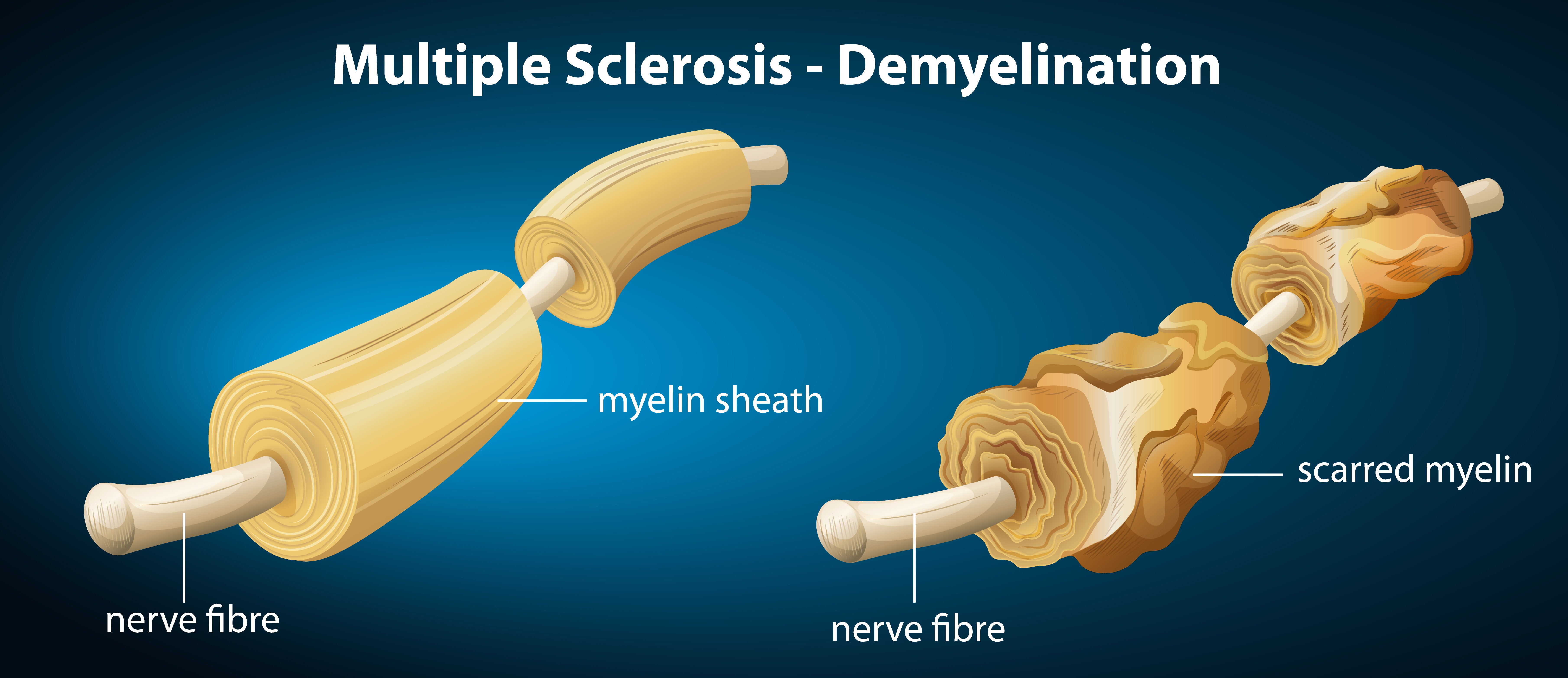Demyelination is the loss or damage to the myelin sheath, the protective covering that surrounds nerve fibers and allows signals to be quickly and efficiently conducted along neurons.
When myelin is damaged or stripped away, neuronal signaling slows, leading to impaired sensation, movement, cognition, or other nervous system functions.
This loss impairs efficient electrical signal transmission along the neuron, potentially leading to neurological symptoms.
Disorders such as multiple sclerosis are characterized by demyelination, causing symptoms ranging from muscle weakness to impaired coordination or vision.

Myelin Sheath
How well impulses travel down the nerves determines how smoothly and quickly a person can perform everyday movements.
Nerve cells have a coating of the myelin sheath surrounding their axon. Myelin is a fatty white substance that protects the axons and enables electrical impulses to pass along the nerves quickly.
Myelin is made of membrane layers that cover the axon, like electrical wires with a coating to protect the metal underneath.
In myelinated neurons, a signal can travel about 100 meters a second, whilst in unmyelinated neurons, a signal can travel about 1 meter a second.

Therefore, without myelin, many functions, actions, and movements will be slower, less coordinated, or not function at all.
Some conditions and illnesses can cause a loss of myelin by wearing it away or damaging these protective layers. Damage to the myelin is called demyelination.
Demyelination can slow down the speed of messages being communicated between neurons and causes the axons to deteriorate.
This can lead to the neurons weakening, which can cause problems in the brain and throughout the nervous system, including the spinal cord and peripheral nerves.

Some neurological deficits as a result of demyelination include vision changes, weakness, altered sensation, and behavioral or cognitive problems.
Some of the symptoms of demyelination can be temporary, and recovery is possible, whereas other conditions can be more serious and even life-threatening.
Symptoms
The symptoms that are experienced by demyelination depend on the condition and where in the nervous system the demyelination has occurred.
The symptoms of demyelination correspond to the area of the nervous system affected. For instance, peripheral neuropathy affects the hands and feet.
Demyelination affecting the lower spine or spinal nerves can cause problems in the legs, bowel, and bladder. In contrast, demyelination in the brain can cause various cognitive problems or issues with vision.
Not everyone who is affected by demyelination has the same symptoms, although some are very common. Early signs that are among the first symptoms of demyelination include:
-
Loss of vision
-
Unusual nerve pain
-
Bladder or bowel problems
-
Overall fatigue
Depending on the condition, the symptoms of demyelination may come and go, or they may gradually worsen. In multiple sclerosis, for instance, which is a common chronic condition, the symptoms can come and go and progress over the years.
Below are some of the common areas where demyelination can cause impairments and how they affect different parts of the nervous system:
Vision
Demyelinating conditions can lead to blurry or double vision. They can also result in a loss of vision that can be either temporary or permanent, depending on the severity of the demyelination.
Reflexes and movement
Demyelination can cause changes to the motor system which can lead to muscle weakness, stiffness, uncoordinated movements, and problems with balance.
This can ultimately affect how someone moves, meaning that they may not be able to perform some motor tasks or find it harder to walk, speak, or swallow.
Sensations
Those with demyelinating conditions may experience numbness and tingling, burning, or prickling sensations in their arms, legs, or feet.
In some cases, they may even feel pain when touched lightly, which can make it extremely difficult to navigate life as normal.
Cerebellum
The cerebellum is a part of the brain that plays a role in controlling balance and coordination. Demyelination in this area can lead to tremors or incoordination such as finding it harder to walk without losing balance.
Genitourinary system
Some people with demyelinating conditions may experience problems with urination and bowel movements. This can also affect sexual health and make someone more likely to develop a urinary tract infection (UTI).
Mood and thinking
There may be changes in mood associated with demyelination, such as many experiencing depression, anxiety, and irritability.
There may also be problems with thinking, such as memory issues and a loss of focus, with some taking longer to process their thoughts.
Blood pressure and heart
In some cases, demyelination may result in people having poorer control over their blood pressure, as well as having a racing heartbeat or palpitations with no apparent cause.
What causes demyelination?
Demyelination occurs when there is a loss of myelin. When there is a deficiency or a sudden decrease in myelin, the nerves may not be able to function at all, resulting in neurological problems associated with demyelination.
There are different types of demyelination, the most common being inflammatory. Inflammation can result from an immune response that goes wrong and causes the body to attack its own tissues, becoming an autoimmune condition.
Types of demyelination conditions such as multiple sclerosis (MS) are caused by inflammation in the brain and spinal cord, resulting in the body’s immune system attacking the myelin.
Another condition known as Guillain-Barre syndrome (GBS) involves inflammatory demyelination of the peripheral nerves in other parts of the body.
Demyelination can also be caused by viral infections. Viral demyelination occurs with progressive multifocal leukoencephalopathy (PML), another demyelinating condition.
PML is caused by the JC virus, a common germ that more than half of adults have been exposed to and usually does not cause problems but can be dangerous to those with a weak immune system.
Aside from inflammatory and viral causes, in some cases, the cause of demyelinating conditions is unclear, although they can result from the following risk factors:
-
Genetics
-
Damage to blood vessels in the brain
-
A lack of oxygen to the brain
-
Nutritional deficiencies
-
Toxicity
Damage to myelin can also occur alongside:
-
Alcoholism
-
Liver damage
-
Electrolyte imbalances
-
Vascular disease
Diagnosis
Demyelinating conditions can be diagnosed by using different methods. However, sometimes the signs and symptoms can be confusing, and it may take a long time to determine the type and cause of demyelination.
A medical history is usually established to understand if there are any genetic disorders that could explain why someone is experiencing symptoms of demyelination.
The healthcare provider will ask for details about how long the symptoms have lasted, whether they have been experienced in the past, and whether the person has recently had an infection. The person will likely be asked about other symptoms being experienced, such as pain, nausea, vomiting, and fevers.
A physical examination will usually be completed to check muscle strength, sensations, coordination, and the ability to walk. Depending on the symptoms, an ophthalmologic exam may be necessary, in which the healthcare provider looks at the eyes to see if demyelination has occurred in the optic nerves.
Physical exams are useful for establishing whether the brain, spine, optic nerves, or peripheral nerves have been affected.
In some instances, brain imaging techniques may be necessary to diagnose a demyelinating condition. Brain or spine imaging, such as magnetic resonance imaging (MRI), can often identify areas of demyelination in the central nervous system.
Often, there are patterns of demyelination that correspond to different conditions. Demyelinating conditions, such as multiple sclerosis and optic neuritis (inflammation of the optic nerve), are detectable with MRI scans. MRIs can reveal demyelination plaques in the brain and nerves.
There are also some types of non-invasive diagnostic tests that can be used to identify the effects of demyelination on the peripheral or optic nerves:
-
Electromyography (EMG) – this is done as part of a neuropathy evaluation. This test is used to measure the muscle’s response to nerve stimulation.
-
Nerve conduction studies (NCV) – like EMG, NCV studies are completed to evaluate peripheral neuropathy. This type of test measures how fast the nerves conduct electrical signals. It involves direct stimulation of the nerve by shock-emitting electrodes that are placed on the skin directly over the nerve.
-
Evoked potentials – these tests are used to measure the brain’s response to certain stimuli. Visual evoked potentials, for instance, measure the brain’s response to light and other visual stimuli.
-
Lumbar puncture (LP) – often referred to as spinal tap, this test allows the examination of cerebrospinal fluid (CSF). CSF often shows signs of infection or inflammatory disease, and the result can be used to assist in the diagnosis of demyelinating conditions.
Demyelinating Disorders
Disorders of the brain and spinal cord:
Multiple sclerosis (MS)
MS is the most common demyelinating condition which is characterized by demyelination in the brain, spine, and/or optic nerve.
This occurs when the immune system attacks myelin in the central nervous system, causing hardened scars on the myelin which leads to various symptoms of demyelination that can impact a wide range of body functions.

For a small number, the symptoms can remain mild, whilst for others, they can become severe. This condition usually starts between the ages of 20 and 40 years old for most people.
Whilst MS can be manageable, it is a lifelong illness with no definitive cure. There are different types of MS:
-
Clinically isolated syndrome
-
Relapsing-remitting MS
-
Primary progressive MS
-
Secondary progressive MS
Acute disseminated encephalomyelitis (ADEM)
ADEM is a rapidly progressive episode that often affects young children. This is characterized by short but widespread bouts of inflammation.
The symptoms are usually more intense than those of MS. However, the condition usually resolves itself over time without lasting effects or relapse.
Progressive multifocal leukoencephalopathy (PML)
PML is a severe demyelinating condition that occurs due to the reactivation of a virus. The JC virus is an infection that most people have been exposed to, and it typically causes a mild cold.
However, in rare cases of people with immune deficiencies, this virus can be reactivated. This can lead to extensive issues within the brain, often with permanent neurocognitive impairment.
Optic neuritis
Optic neuritis affects the optic nerve, an important nerve that works to communicate sensory information from the eye to the brain. Optic neuritis occurs when inflammation and demyelination affect this nerve.
This can affect one or both eyes, and its symptoms include changes in vision and eye pain.
Disorders of the peripheral nerves
Guillain-Barre syndrome (GBS)
GBS is an autoimmune condition where the immune system attacks the nerves of the peripheral nervous system. In some varieties of GBS, the immune system attacks myelin, causing weakness that begins in the feet and spreads to the legs and arms within days.
GBS is a sudden and rapidly worsening illness that can become so severe that it results in paralysis. This condition typically affects adults over the age of 50 and affects both sides of the body.
This is a serious condition since it can also cause the weakening of the respiratory muscles that control breathing.
Charcot-Marie-Tooth disease (CMT)
Another condition that causes damage to the peripheral myelin is CMT. This is an inherited condition that results from a genetic mutation that can impact the structure or function of myelin.
This is a progressive condition, meaning that the symptoms will gradually worsen over time. Those with this condition typically have trouble with movements, such as having weak muscles in the limbs, muscle cramps, and limited ability to feel sensations such as touch and temperature.
The symptoms usually show up in the late teenage years or early adult life, but they can come on in midlife as well.
Treatment
The treatment options for demyelination depend on the conditions and the severity of the symptoms. Currently, there are no treatments that effectively restore or rebuild myelin, but usually, myelin will often regenerate on its own.
The growth of new myelin can occur in areas of damage, although this myelin is often thinner and not as effective. If there is little or no nerve damage, the symptoms can resolve, and recovery from the symptoms of demyelination is possible.
Treatments for demyelinating conditions work to reduce the immune response, are focused on managing the symptoms, and preventing further demyelination.
Below are some of the ways in which demyelination can be treated:
Immunosuppression
Being able to prevent the inflammation of many conditions, such as MS, ADEM, and GBS, is a key part of the treatment. Many of these conditions are treated with a brief course of intravenous steroids or plasma exchange.
Plasma exchange is a common treatment that involves removing some of the liquid parts of the blood, called plasma, and replacing it with a manmade version. Plasma exchange is a common treatment for GBS.
Since MS is chronic, it can be managed with disease-modifying therapy (DMT). Steroids and DMTs work by suppressing the immune system to prevent further inflammation destruction on the myelin.
It is advisable that DMT is prescribed from the earliest possible stage which is when the treatment appears to be the most effective.
Treatment for symptoms
Since people with demyelinating conditions often experience a lot of different symptoms, these symptoms can be targeted in treatment to help make the condition more bearable.
For instance, medication to help control the pain and discomfort surrounding a person’s condition, medications for associated anxiety and depression, and medication for bladder dysfunction can all be used to improve the quality of life of these individuals.
For CMT, for instance, whilst there is no known cure and it is progressive, medications can be given for the pain.
Supplements
There is thought to be an association between demyelination and nutritional deficiencies, specifically with B12 and copper. Therefore, supplementing these nutrients to recommended levels may be an important treatment strategy.
Therapy
For many people with demyelinating conditions, rehabilitation therapy is the key to recovery. Physical therapy, occupational therapy, balance therapy, and speech or swallow therapy are types that can all help to either recover from or to help someone cope with their condition.
The treatment for CMT, especially, focuses heavily on physical and occupational therapy, with interventions to help the person to learn to use their affected limbs again, maintain flexibility and muscle strength, and find ways to perform daily tasks.
Physical therapy can also help with coordination and balance problems which are prevalent in many conditions of demyelination.
References
Railton, D. (2021, November 28). What is demyelination, and what causes it? Medical News Today. https://www.medicalnewstoday.com/articles/318750
Apetauerova, D. (2021, September 20). An Overview of Demyelination. Very Well Health. https://www.verywellhealth.com/demyelination-4691934#toc-causes
Healthline Editorial Team. (2019, October 1). Demyelination: What Is It and Why Does It Happen? Healthline. https://www.healthline.com/health/multiple-sclerosis/demyelination
Reiff Ellis, R. (2020, August 9). What Are Demyelinating Diseases? WebMD. https://www.webmd.com/multiple-sclerosis/what-are-demyelinating-disorders
National Multiple Sclerosis Society. (n.d.) Understanding MS. Retrieved 2022, January 10, from https://www.nationalmssociety.org/What-is-MS/MS-FAQ-s
Centers for Disease Control and Prevention. (2019, December 20). Guillain-Barré Syndrome. https://www.cdc.gov/campylobacter/guillain-barre.html

